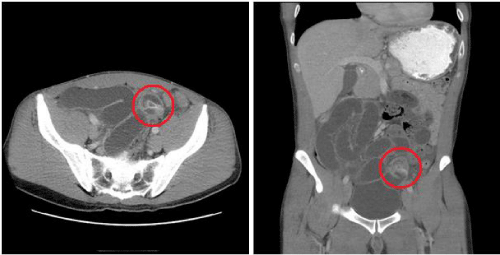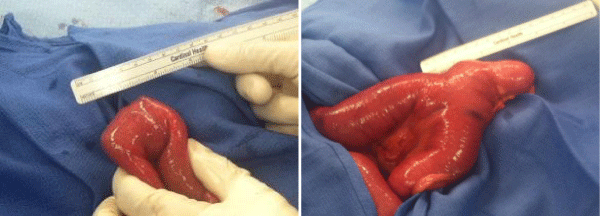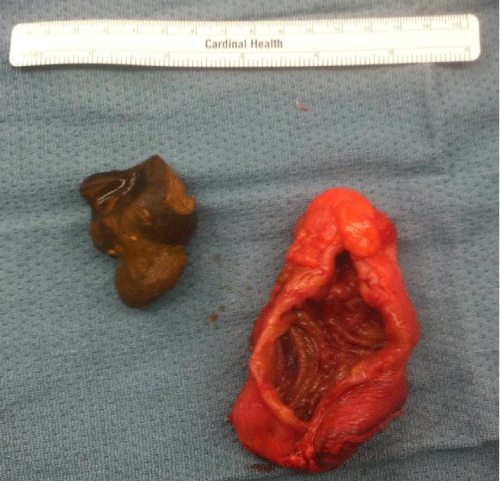
Case Report
Austin J Surg. 2014;1(4): 1018.
Phytobezoar in a Meckel’s Diverticulum Associated with Recent Adoption of a Paleolithic Diet
Xiang M1, Mazer LM1,2, Gupta A1,2 and Odom SR1,2*
1Department of Surgery, Harvard Medical School, USA
2Department of Surgery, Beth Israel Deaconess Medical Center, USA
*Corresponding author: Odom SR, Department of Surgery, Harvard Medical School, Beth Israel Deaconess Medical Center, Boston, MA, USA
Received: June 13, 2014; Accepted: July 21, 2014; Published: July 26, 2014
Abstract
A healthy 33 year old male who had three weeks ago adopted a Paleolithic, or “paleo’ diet, presented with nausea and vomiting. Computed tomography identified a complete small bowel obstruction (SBO) that failed to resolve after initial conservative management. At surgery he was found to have a phytobezoar in conjunction with a Meckel’s diverticulum. We report the first known case of phytobezoar in association with recent adoption of the Paleolithic diet. We discuss the Paleolithic diet as an increasingly significant fad diet in the United States. Furthermore, we discuss diagnostic clues on pre-operative history, physical examination and radiography that may lead to early recognition such as the bowel target sign. Finally, we suggest surgical management (either open, as in this case, or laparoscopic) as treatment and describe our experience in this case of milking the bezoar into the Meckel’s diverticulum prior to resection of the entire lesion. In conclusion, we warn of a possible association between an increasingly used fad diets (1-3 million Americans currently subscribe to the “paleo’ diet), Meckel’s diverticulum (2% of the population) and phytobezoar.
Keywords: Phytobezoar; Paleolithic diet; Diverticulum
Case Presentation
A previously healthy 33 year-old male presented with a one day history of nausea, crampy abdominal pain, and obstipation. He had a laparoscopic appendectomy at age 17. Three weeks prior, he started the Paleolithic diet and had been eating large quantities of salad, carrots, and zucchini. Examination revealed moderate periumbilical and right lower quadrant tenderness with voluntary guarding and no rebound. Vital signs, basic metabolic panel, and complete blood count were within normal limits. Computed tomography of the abdomen revealed complete small bowel obstruction (SBO) with concern for intussusception (Figure 1). He was admitted and treated with nasogastric decompression, intravenous fluid hydration, and bowel rest. Due to persistent pain and no return of bowel function after two days, he was taken to the operating room for exploratory laparotomy. An impacted phytobezoar was discovered obstructing the intestinal lumen 2cm distal to a previously unappreciated Meckel’s diverticulum (Figure 2). The bezoar was manually retropulsed into the diverticulum, which was resected, followed by primary side-to-side anastomosis. Post resection, the bezoar was noted to conform to the walls of the diverticulum (Figure 3). The patient tolerated the procedure well, and was discharged home after return of bowel function. At 1 month follow-up, he had recovered fully with no recurrence of SBO.
Figure 1 :Computed tomography scan with representative axial slice (left) and coronal reconstruction (right) showing dilated loops of small bowel indicative of high-grade SBO. The phytobezoar in the left lower quadrant (circled) was originally interpreted as possible intussusception.
Figure 2 : Left: Appearance of phytobezoar in situ. Right: Meckel’s diverticulum after replacement of bezoar within diverticular sac.
Figure 3 : Phytobezoar and opened diverticulum post resection.
Discussion/Conclusion
Phytobezoars are concretions of indigestible vegetable matter within the gastrointestinal tract that account for up to 4% of SBOs [1]. Meckel’s diverticular, present in 2% of the population, may predispose to phytobezoar formation, and phytobezoars causing SBOs in this context have been documented in 10 individual case reports. However, an association between phytobezoars and contemporary high-fiber fad diets has not been previously described. The increasingly popular Paleolithic or “Paleo’ diet features significant consumption of vegetables, fruit, roots, seeds, and nuts, all known sources of increased incidence of bezoar.
Here, we describe the case of a young man with Meckel’s diverticulum and phytobezoar-induced SBO occurring 3 weeks after adoption of the Paleolithic diet. Our patient recently adopted the Paleolithic diet in the setting of a Meckel’s diverticulum that was not uncovered until exploratory laparotomy. Both of these factors likely contributed to the development of obstructive phytobezoar. The Paleolithic diet, which is becoming increasingly popular due to purported benefits to waist circumference and metabolic parameters [2], emphasizes vegetables, fruit, roots, nuts, seeds, and meat while excluding grains, legumes, and dairy. As of 2013, an estimated 1-3 million Americans were adherent to the Paleolithic diet [3], and it was the most searched-for diet of the year on Google [4]. Likewise, Meckel’s diverticulum is common: at 2% prevalence, it is the most frequently encountered congenital abnormality of the GI tract. While usually asymptomatic, Meckel’s diverticula occasionally cause bleeding, obstruction due to volvulus or intussusception, or diverticulitis.
General risk factors for phytobezoar-induced SBO include consumption of high-fiber foods and poor dentition or inadequate mastication [1]. Bezoars that form in the stomach and later pass into the small bowel often occur in patients with a history of gastric surgery, outlet obstruction, or dysmotility. Both overly rapid and delayed emptying predispose to bezoar formation, mediated by insufficient digestion and stasis of gastric contents, respectively. Primary bezoars of the small bowel are rarer, and may develop secondary to adhesions, tumors, strictures, or diverticula. The most common site is 50-70cm proximal to the ileocecal valve due to its narrow caliber, slower peristalsis, and hardening of luminal contents by water uptake [5]. Interestingly, this is also the typical location for Meckel’s diverticulum.
The diagnostic test of choice is CT scan. Classically, phytobezoars are well-defined masses with internal heterogeneity and an encapsulating wall [6]. However, impacted gallstone and the small bowel feces sign can have a similar appearance. The latter tends to be more amorphous, unencapsulated, and located more distally from the transition point [6]. In addition, phytobezoars of soft tissue attenuation and lacking internal heterogeneity can be mistaken for intraluminal tumors or intussusception [1]. Indeed, the CT scan of the patient in this case was originally felt to be concerning for intussusception, and the small bowel target sign construed as intussusception has been previously observed for an obstructing phytobezoar ejected from Meckel’s diverticulum [7].
Treatment of phytobezoar-induced SBO is surgical. If possible, the mass should be manually fragmented and then milked into the cecum. In cases of severe impaction, anatomical abnormality, or the presence of complications, enterotomy or segmental bowel resection may be required. Moreover, evaluation of the entire length of bowel is warranted since about one-third of patients have multiple intestinal bezoars [6]. The traditional approach is open surgery, but laparoscopic treatment of obstructing phytobezoar in a Meckel’s diverticulum, though challenging, has been tried successfully [8]. Importantly, unlike adhesion-induced SBO which can be initially conservatively managed, delaying surgery for bezoar-induced SBO is associated with increased morbidity [1]. Since their clinical presentations are identical, increased clinical vigilance and careful diagnosis on CT scan are critical.
While obstructive phytobezoar in the context of Meckel’s diverticulum has been reported, our case is the first known to be associated with the Paleolithic diet. While no direct link between the diet and the bezoar can be proven, there is temporal relationship as well as a known association between diets high in plant material, seeds, and other indigestible materials and bezoar formation [1]. Classic dietary culprits for bezoar formation include persimmons, figs and dried fruits [8], though many other associations have been made [9-10]. In addition, there is suggestion in the literature of an association between dietary fibrous material and diverticuli with bezoar formation. For example, Plath and colleagues report a case of an 87 year old woman with (gall) stone formation from the fibrous stalk lodged in a duodenal diverticulum [11]. In addition, seven cases of appendicitis (so called “micro phytobezoars’) were reported in association with high dietary plant intake [12]. Phytobezoar in association within a Meckel’s has been reported nine times in the English literature [13]. This case highlights the importance of dietary assessment in the evaluation of suspected SBO. The finding of adherence to the Paleolithic or other high-fiber fad diets should increase suspicion for obstructive phytobezoar and also lower the threshold for operative management if the cause of SBO is indeterminate, since surgery for phytobezoar-induced SBO should not be delayed. Given the prevalence of Meckel’s diverticula and the Paleolithic diet, as many as 60,000 Americans may be at increased risk for phytobezoar-induced SBO, underscoring the importance of maintaining a high index of suspicion for this diagnosis.
Phytobezoar-induced SBO in the setting of Meckel’s diverticulum is rare. We report the first case of this diagnosis in association with recent adoption of the Paleolithic diet, suggesting that increased awareness can lead to better recognition of this entity, especially as high-fiber fad diets become increasingly popular.
References
- Yakan S, Sirinocak A, Telciler KE, Tekeli MT, Deneçli AG. A rare cause of acute abdomen: small bowel obstruction due to phytobezoar. Ulus Travma Acil Cerrahi Derg. 2010; 16: 459-463.
- Lindeberg S. Paleolithic diets as a model for prevention and treatment of Western disease. Am J Hum Biol. 2012; 24: 110-115.
- Schwartz DB, Stapell HM. Modern Cavemen? Stereotypes and Reality of the Ancestral Health Movement. Journal of Evolution and Health. 2013; 1.
- Google. Google Trends - Diets Top Chart. 2013.
- Oh SH, Namgung H, Park MH, Park DG. Bezoar-induced Small Bowel Obstruction. J Korean Soc Coloproctol. 2012; 28: 89-93.
- Salemis NS, Panagiotopoulos N, Sdoukos N, Niakas E. Acute surgical abdomen due to phytobezoar-induced ileal obstruction. J Emerg Med. 2013; 44: e21-23.
- Datta I, Ball CG, Cox H, Pasieka JL. Computed tomography target sign: a case of mistaken intussusception. Indian J Surg. 2011; 73: 76-77.
- Fagenholz PJ, de Moya MA. Laparoscopic treatment of bowel obstruction due to a bezoar in a Meckel's diverticulum. JSLS. 2011; 15: 562-564.
- Serrano KD, Tupesis JP. Small bowel obstruction from potato and broccoli phytobezoar mimicking mesenteric ischemia. J Emerg Med. 2013; 44: 79-81.
- Bini R, Quiriconi F, Tello A, Fusca M, Loddo F, Leli R, et al. Phytobezoar in Meckel's diverticulum: A rare cause of small bowel obstruction. Int J Surg Case Rep. 2012; 3: 161-163.
- Plath F, Brock P, Hasse N, Liebe S, Arendt T. Vegetable stalk as a nidus for gallstone formation in a patient with a juxtapapillary duodenal diverticulum. Gastrointest Endosc. 2002; 56: 944-946.
- Engin O, Yildirim M, Yakan S, Coskun GA. Can fruit seeds and undigested plant residuals cause acute appendicitis. Asian Pac J Trop Biomed. 2011; 1: 99-101.
- Bingham JR, Causey MW, Haque MI. Phytobezoar within Meckel's diverticulum: an unusual cause of intestinal obstruction. Am Surg. 2014; 80: E94-96.


